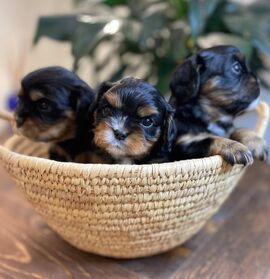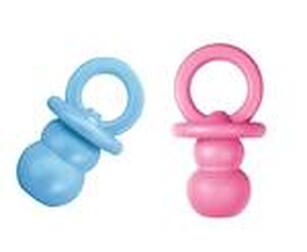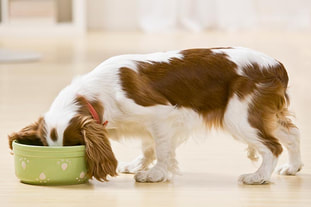 We frequently get requests to purchase two puppies from the same litter as families like the idea of their dog having a playmate and being raised with a sibling / littermate. Many people also (mistakingly) think raising two puppies at the same time will be easier than just having one. While it sounds enticing, we want to make sure that prospective owners are familiar with a very real issue labeled "littermate syndrome" before making the decision to purchase two pups. Littermate syndrome refers to a condition that can occur when two puppies from the same litter are raised together in the same household. It is characterized by an unusually strong bond between the littermates, which can lead to behavioral and developmental issues if not properly managed. When two puppies are raised together, they may become overly dependent on each other and have difficulty forming strong bonds with humans. They may exhibit separation anxiety when separated, struggle with socialization and training, and have difficulty adapting to new environments or experiences outside of their sibling relationship. Littermate syndrome can manifest in various ways, such as increased aggression or fearfulness towards other dogs or people, difficulty focusing on individual training, and an overall lack of independence. The strong bond between the littermates can prevent them from fully developing their own identities and learning important social skills. When our prospective families ask to purchase littermates, we discourage but we don't refuse. Instead, we educate families on how to mitigate littermate syndrome, Taking proactive measures from the beginning can help eliminate the issues. Here are some strategies to help: 1. Separate their living spaces: Provide separate sleeping areas and crates for each puppy to promote individuality and prevent excessive dependence on one another. This helps them develop independence and reduces the likelihood of separation anxiety. 2. Individual attention and training: Spend quality time individually with each puppy. Engage in separate training sessions, playtime, and walks to establish a bond with each dog. This helps them develop their own relationship with humans and build confidence outside of their sibling dynamic. 3. Socialization with other dogs and people: Expose each puppy to a variety of social situations, different dogs, and new people. This helps them learn how to interact with others, build their social skills, and become well-rounded dogs. 4. Separate training sessions: Train each puppy separately to ensure they learn to respond to commands individually and focus on their own training. This prevents them from relying solely on each other for cues and commands. 5. Independent experiences: Allow each puppy to have separate experiences outside of their sibling relationship. Take them on individual outings, introduce them to new environments, and expose them to different stimuli to build their confidence and adaptability. 6. Gradual separations: Gradually increase the time spent apart from each other. Start with short separations and gradually extend the duration. This helps them learn that being alone is not a cause for distress and reduces separation anxiety. 7. Seek professional guidance: Consult with a professional dog trainer or behaviorist who has experience with littermate syndrome. They can provide personalized advice and guidance to help you navigate through the challenges and create an effective training plan. Remember that preventing littermate syndrome requires consistent effort and dedication. Providing individual attention, training, and socialization opportunities will go a long way in ensuring that your Cavalier King Charles Spaniel puppies develop into well-adjusted, independent dogs.
0 Comments
 Keeping your CKCS busy is essential for effective training. It facilitates easier crate training, lessens destructive behaviors like chewing on shoes & furniture, eases teething discomfort, and provides a distraction from nipping or barking. It's best to have a toolkit of options on hand when training a puppy and then switching things up to keep things interesting. This may seem like a big list, but it will likely take some trial and error to determine which methods will work for your puppy. Something they didn't love? Donate any stuff your puppy doesn't use or love to your neighborhood animal shelter so they can be given to puppies in need. Here is the list of supplies we keep on hand:: CRATE TRAINING - Making the crate or pen somewhere your puppy likes to go is vital to crate training. It should be a safe area and provide some stimulation to cut down on boredom, barking, and whining. Feeding your puppy in the crate, while also offering stimulating treats, is one simple method to make that happen. Look for durable items that can be offered unattended when shopping for crate training items. Avoid anything that could choke your puppy (for example puzzle pieces or small toys), and never utilize rawhide (inside our outside of the crate). Here are our best recommendations on Amazon:
GENERAL CHEWING – Dogs chew for various reasons, such as boredom and teething. Determining the cause of your dog's chewing may assist you in selecting the ideal toy or item to reduce or eliminate the need to chew personal items. Additionally, increasing activity and mental stimulation through training is always the greatest remedy if your dog is just bored. These are a few of our preferred options for cerebral stimulation and teething:
TRAINING TREATS – Training your puppy is fantastic because it stimulates the mind and helps control undesirable behaviors, but also strengthens the bond between you and the puppy. The secret to successful training is to determine a reward that's meaningful to your puppy. For most pups. that's treats. Many dog treats include unhealthy substances and other items that could hurt your puppy, so please only train with high quality (preferably single ingredient) treats. Try several of these treats to find one your puppy truly appreciates. Here are some of our much-loved treats, but don't be shy about trying other homemade goodies like deli meat, ground beef, etc.
Although the focus of this post has been on pups, we use every product here for our adult dogs too — we just size up on some Kong-style toys and don't cut the goodies in half! Best wishes on keeping your dog busy. WANT TO LEARN MORE - See our other post related to this topic on WORKING FOR FOOD.  We like using the Kong to train and entertain puppies. Read more about Kongs and training here. Some of our puppy owners are unsure of how to utilize the Kong and specifically pique a puppy's interest in playing with it. We also hope to avoid owners using the unhealthy options for Kong stuffing offered in pet stores. Here are a few basic tips and recipes to get you started on Kong stuffing, and to give you the confidence to start developing your own recipes. TIPS FOR BEGINNERS: • Begin by using your pet's own food in the Kong. When the dog is hungry and eager to work for his or her food, provide the Kong BEFORE any meal. This aids with the puppy's conceptualization. You might want to start with high-quality kibble in the Kong if you feed soft food. • Once your puppy has a basic understanding of the idea of struggling to retrieve his or her food from the Kong, make it more challenging by inserting an edible plug for them to figure out before getting the food. Depending on the size of your Kong, you might want to try a blueberry, some peanut butter, some cheese, or even a reward that you can shape, like Little Jacks Dog Training Treats. • Once your puppy has mastered the fundamentals of a Kong, you may start getting more inventive. Use the following to maintain your dog's interest:
SHOPPING LIST:
RECIPES:
These are only a few suggestions to assist you in Kong stuffing. Don't be scared to try out several recipes to identify a few personal favorites for your CKCS. Just be mindful of the extra calories and sugar, and think about giving your dog's stuffed Kong when ensuring they have a balanced diet. Have a preferred Kong recipe? Please share it with us in the comments!  Daily, well-intentioned users of various Facebook forums will ask other well-intentioned users what they ought to feed their puppy. Then, members who are not veterinarians, breeders, or who have even read the contents of their own dog's food will advise prospective dog owners on what food to buy, typically based on what their dog "likes." Inevitably, more people will join in to express their disapproval of the decision to feed kibble in the first place, and by the time the discussion is over, I expect many group members will regret asking the question because they received more than 50 unhelpful responses. Please keep in mind that we are NOT veterinarians; however, we are very careful about what we feed our dogs. We converse with other breeders. We examine labels. We talk with our vets. We research dog food. We also don't judge other people's feeding choices as long as they do all they can to provide for their dogs. Every dog, every owner, and every breed is unique. Owners are advised to look into each of the following possibilities when deciding what to feed their new pet: 1. RAW FEEDING - Raw feeding is a divisive subject. Those who support raw feeding feel anything less is unacceptable. While we recognize the advantages of raw feeding, we also acknowledge that it may not be a feasible option for every pet owner. If seriously interested in raw feeding, we advise you to contact Dr. Judy Morgan to learn more, particularly for breeds related to Cavaliers. Here you can check her recipe for puppy loaf, a delicious introduction to feeding raw. The local specialized pet stores also offer raw options including brands we trust such as Answers, Primal Raw, and Instincts Raw, All of these are balanced and convenient raw options we have used to feed our dogs. These raw options are highly recommended and most dogs find them palatable and easy to digest. 2. HOME COOKED - Many new pet owners are unclear about the distinction betweenraw and "home-cooked," This term simply defines those who make their dog's food at home using items such as lean meats, veggies, and carbs, and "raw feeding," which is based on foods that are not prepared. It's simple to get this wrong. For instance, the puppy loaf that we discussed earlier, which can be eaten raw or cooked, would fit into both categories. However, preparing meals at home can be labor-intensive, expensive, and difficult (to make sure your dog gets all the nutrients needed). Having said that, our dogs adore home-cooked foods, which are particularly excellent for canines with certain dietary requirements or severe allergies. Dogs today also have the fantastic option of receiving "home-cooked" meals that have already been thawed and delivered to you. Our dogs are currently fond of Ollie, which we will cover in more detail in an upcoming post. 3. Kibble - Going back to the initial topic, people frequently wonder what kind of kibble they should give their dogs and it is by far the most popular option. Due to misleading packaging, recalls & low-quality ingredients, kibble has received a terrible reputation in recent years. Having said that, kibble has its place. For instance, we prefer to feed our dogs home-cooked meals & raw meals whenever possible, but we occasionally utilize kibble for training, stuffing Kongs, supplemental feeding during pregnancy, traveling, and handing over puppies to new homes. Here is how we suggest you choose a kibble for your puppy:
2. Blue Buffalo Life Protection Puppy 3. Orijen Puppy 4. Victor Purpose Nutra Pro (Suitable for dogs & puppies) 5. NuLo Freestyle Puppy & Adult Small Breed (Grain Free) 6. Diamond Naturals Small Breed 4. Visit your neighborhood specialty pet store. Yes, they can occasionally be more expensive, but they also offer excellent advice (speak with the owner or a knowledgeable employee) and frequently have free samples of the food available for your dog to taste before committing to a large bag. In order to compete with Amazon, Chewy, and other online retailers, they also offer rewards and loyalty programs that frequently lower the price of their food. Dog food is ultimately a personal decision dependent on your dog, your schedule, and your money. Don't leave that decision in the hands of strangers who have little or no understanding of any of those things. |
FTC DISCLOSUREThis blog contains affiliate links. I may earn commissions from qualifying purchases made from links on this blog. We do not recommend any products that we do not purchase and use for our dogs. Categories
All
Archives
June 2024
|
 RSS Feed
RSS Feed